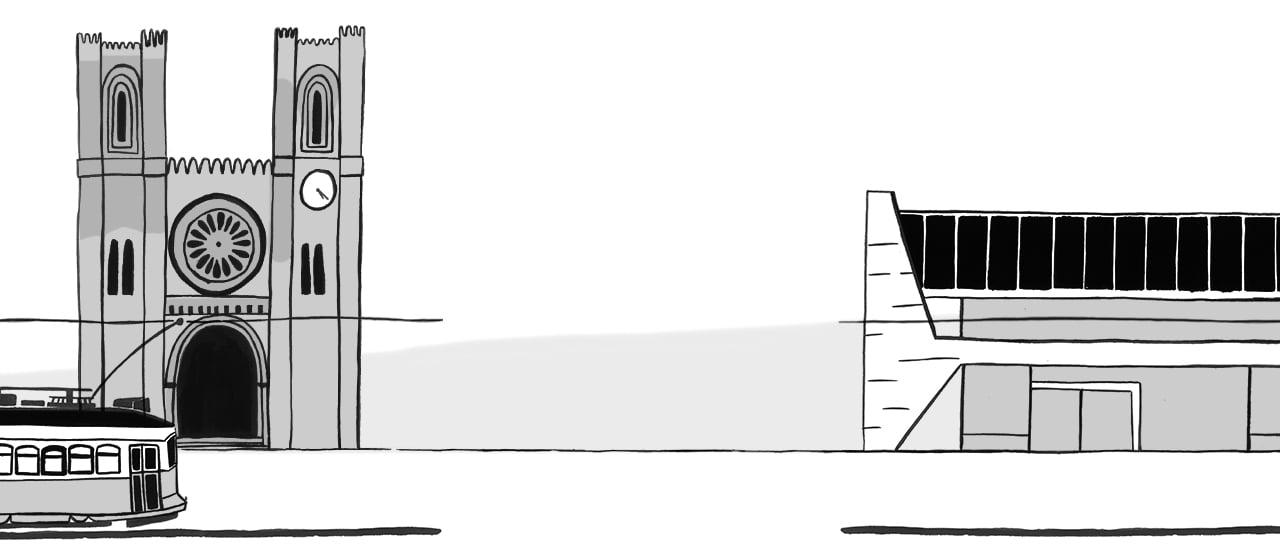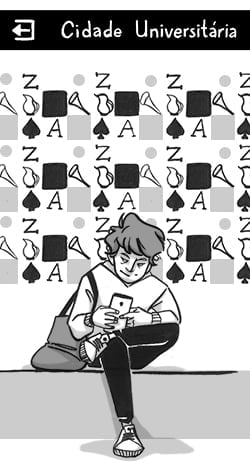
PEEK THROUGH OTHER WINDOWS
Lisbon does not parade at the window as I move, as if it made a night trip with the curtain closed. Between one stop and another, a beam of light, the amazement, a museum of different styles, large rooms, where architecture intersects with painting, sculpture and words. Every day I discover a new stop, a new artist, and, when I ascend to the surface, I am close to a cathedral, a museum, a church. All the guides suggest a ride on Tram 28, but a long-time friend introduced me to a poem that says: “No, I won’t go that way! I only go where my own steps take me…” (Black Chant, José Régio) and I made it my motto in the city, such as in life.
Discovering Lisbon by following the different Tube lines is, in itself, a cultural experience. Meeting Siza Vieira, one of the greatest in world architecture, in Baixa-Chiado (blue line). Diving in the colourful world of the visual artist José de Guimarães, in Carnide (blue line). Admiring the geometrical compositions that celebrate the couple Arpad Szenes and Vieira da Silva, reproduced in tiles, by another great artist of painting and ceramics, Manuel Cargaleiro, in Rato (yellow line). I follow the rushed steps of the rabbit from Alice in Wonderland, by Lewis Carroll, drawn by the surrealist António Dacosta and interpreted by Pedro Morais. I never get tired of the words of Almada Negreiros inscribed in Saldanha (red line): “When I was born, all the sentences to save humanity had already been written, just one thing was lacking – to save humanity”.
On the surface, every man if for himself, among tuk-tuks with no rules, slow trams, illegally parked cars, erratic scooters. Better to take a cacilheiro boat and see the city at the pace of the Tagus, as if strumming the strings of a Portuguese guitar.


Lisbon has poetry between the lines. In the narrow alleyways of historic quarters, with clothes hanging in the wind and elderly residents at the window. In all that the sight can reach, from viewpoints on the top of its seven hills to the architectural traces which circumvent the dome of the National Pantheon, home of the most illustrious Portuguese figures – from Luís de Camões (poet immortalised by its work Os Lusíadas) and Vasco da Gama (Portuguese navigator who discovered the sea route to India) to Amália Rodrigues (the queen of fado) and Eusébio (great footballer, nicknamed the “Black Panther”) –, or follow the modern curves by the river of MAAT-Museum of Art, Architecture and Technology.
From the historical heritage that recalls the 1755 earthquake, such as the Church of São Domingos, in Rossio Square, a living memory of the destruction, later marked by a fire in 1954, which painted it inside in black, or the ruins of the Convent of Carmo, which was the main Gothic church in the capital, now the Archaeological Museum of Carmo, a frequent stage for shows, to the natural heritage of the Botanical Garden, which includes the Museums of Natural History and of Science, which gathers more than 140 years of history and dedication to botanical research, or Estufa Fria, designed at the beginning of the 20th century to house plant species from all over the world, Lisbon cannot fit fully in a window. It takes many trips to discover it. No, I won’t go that way! I sit down for a coffee with Fernando Pessoa, at Brasileira, while I discover his book Lisbon – What the Tourist Should See, another window ajar, waiting for curious looks and adventurous spirits.
OPEN THE CURTAIN…
WHAT TO SEE?
LISBOA
Metropolitano de Lisboa
Fundação Calouste Gulbenkian
Centro Cultural de Belém
Casa dos Bicos
Museu de Lisboa – Palácio Pimenta
Castelo de São Jorge
Mosteiro dos Jerónimos
Museu de Arte Antiga
Sé Catedral de Lisboa
Basílica da Estrela
Reservatório da Mãe d’ Água das Amoreiras
Miradouro do Arco da Rua Augusta
AROUND LISBON
Palácio Marquês de Pombal (Oeiras)
Casa das Histórias Paula Rego (Cascais)
Quinta da Regaleira (Sintra)
Parque e Palácio de Queluz (Queluz)
Parque e Palácio da Pena (Sintra)
Parque e Palácio da Vila (Sintra)
Parque e Palácio da Monserrate (Sintra)
